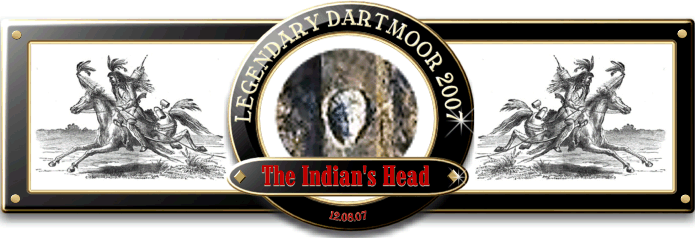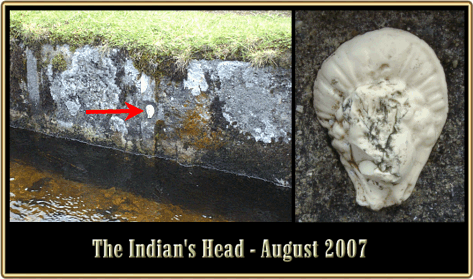
I recently recieved an e mail asking if I knew the whereabouts of the Indian’s Head (visitors book – Aug 12th) which gave me the nudge to feature it on this web page. The Indian’s Head, sometimes called the Turk’s Head was a small porcelain plaque that lay in the granite wall of the Devonport Leat. Whether it was an Indian or a Turk depended on personal imagination but either way it had sat quietly above the rippling leat for centuries. The first literary mention of the Indian’s Head that I have found comes in 1982 when John Robbins in his book – Follow the Leat, (p. 72) notes the following:
“A curiosity to look for in this section of the leat is a tiny carving of the head of a Red Indian set into the rendering between the granite blocks forming the side of the leat. It is only about two inches in diameter and thus is easily missed, looks rather like white marble, and has obviously been pressed into the wet cement. It is some 100 yards from the aqueduct (known locally as the Iron Bridge) and about halfway between a wall that meets the leat at right-angles and the last granite bridge, on the side of the leat nearest the river, and about five inches above the water level. When viewed close to it will be seen to be quite simply but beautifully carved. Some natural black markings on the stone add realism to the face when seen from a distance. It has an obvious indian head dress. It is thought to have been put there by one of the French prisoner-of-war when working on the leat, and is typical of the style of doll’s head of the period. One would like to think it was the work of the prisoner. I am grateful to the Dartmoor National Park Office for this information and to Mr Richard Nicholson… and Mr David Hawkins… who both drew my attention to it, though the latter always knew it as the Turk’s Head“.
If Robbins’ supposition is correct then the first French prisoners arrived at Princetown in 1809 and the last ones left in 1816 so it would mean that the Indian’s Head was possibly placed in-situ somewhere between those dates. This is working on the theory that it was a French prisoner who placed the head whilst out on a working party at the leat. However, a different theory is put forward by Hawkings (1987 p.54) when he suggests that the, “Red Indian”, was embedded in the wall during repairs that were being made to the leat in the 1830’s. He also comments how the head was defaced sometime during 1984. Mike Brown (1999, p. 12) explains that in 1996 a replacement for the original head, which he calls the Turks Head was cemented into the wall of the leat. His directions to find it are:
“This may be seen seventy blocks downstream (south) from the first granite leat footbridge after Iron Bridge, near the first tree situated on the right bank of the leat, the tiny figurine being cemented into the left hand (east) wall“.
The replacement head was actually put in place by a young girl who won a competition that was run by the Dartmoor National Park Authority, the prize being the placing of the head, (Lethbridge, 2006 p.114). I am unable to find the exact reference but I know that somewhere recently I read that once again the Indian’s Head was found to be in disrepair and was taken in for safe keeping, as to whether or not it has been replaced I am unsure. Thanks to Steve Fanstone it can be confirmed that as of August 2007 the head is in-situ albeit slightly damaged and also he has provided a couple of photographs to show all’s well(ish), once again, many thanks for your help Steve

© Steve Fanstone 2007
It must have been about 15 years ago when I went in search of the Indian’s Head and I can remember standing in the leat whilst trying to get a decent photograph. As I was stood in the freezing waters of the leat a party of walkers came by and were clearly mystified as to why someone should be in the leat bent over the wall with a camera in hand – I didn’t bother explaining. Sadly that was in the days when photographs had to be developed and I have since lost the coveted snapshot of the Indian’s Head which means another soaking someday. The other nuisance is that this last visit was pre GPS days so I have no grid reference for the head so the given reference is only an estimation. But I do remember that I found it from the description given by Robbins in his book, if that is any help?
Bibliography
Brown, M. 1999 Dartmoor Field Guides, The Dartmoor Press, Plymouth.
Lethbridge, W. D. 2006 One Man’s Moor, Halsgrove Publishing, Tiverton.
Robbins, J. 1984 Follow the Leat, J. A. C. Robbins, Callington.
Hawking, D. J. 1987 Water from the Moor, Devon Books, Exeter.
 Legendary Dartmoor The many aspects past and present of Dartmoor
Legendary Dartmoor The many aspects past and present of Dartmoor
